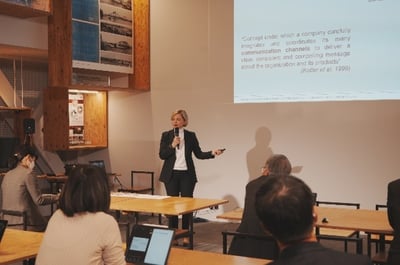Report on the 4th Special Lecture
January 17, 2023
Special Lecture
The Metaverse School of Engineering's 4th Special Lecture featured Ms. Irene Bader, Senior Executive Officer in charge of Global Corporate Communications and Chief Marketing Officer of DMG Mori Seiki Co. She is also the chief marketing officer in charge of global corporate communications. The lecture was delivered in person (and streamed on Zoom) at Haseko-Kuma Hall on Hongo Campus. There were about 10 local participants and over 80 participants including online participants.
Content of Lecture
Lecture: Irene Bader, MBA
Title: Global Marketing Communication in the manufacturing industry
I, Irene Bader, have been working for DMG MORI (DMG Mori Seiki Co., Ltd.) for 18 years. I love the Japanese culture and the people I work with here in beautiful Japan, and I visit Japan 6 to 8 times a year. My role is Global Corporate Communications, and I would like to talk about "Marketing Communications in the Manufacturing Industry".
DMG MORI is a global manufacturer of machine tools with 12,000 employees worldwide and 16 production sites. We have 108 sales and service offices and about 150,000 customers in 43 countries. Roughly 59 nationalities work for us, and we make 8,000 machines a year.
Marketing communications is defined as "reaching, informing, attracting and persuading customers," "a strategically essential tool for the success of any company," and "playing an important role as an intermediary between customers' past and present experiences and their future behavior, especially purchasing behavior". The definition of a "tool" is an indispensable tool in any company's strategy for success. It is also defined as a concept that allows companies to carefully integrate and coordinate a very large number of communication channels to deliver clear, consistent, and compelling messages about their organization and products.
Since DMG MORI is a global machine tool manufacturer, it is essentially a B-to-B business and marketing among companies is fundamental; unlike a B-to-C company such as Amazon, the sales cycle is much longer for a B-to-B business, and buying something takes much longer. The technology is complex and requires considerable explanation before the customer makes a decision.
There have been many types of communication channels for this, starting with trade shows, where it was common to provide information by sending faxes before e-mail became popular. So were pamphlets, direct mail, and telephone calls. Television commercials and radio were another channel. There were also billboards and printed brochures. Before the digital revolution, these methods were just sending messages, known as "outbound marketing. This has now changed from outbound to inbound marketing. Inbound marketing means not only sending information, but also getting customers to find you. There are so many potential customers in society who do not know about our products. So we use various channels of communication, such as social media, to help them find us and our products.

One example of the channels for inbound marketing is search engines. You all know Google, right? We want people to find us in search results. There are also social media channels, blogs, and webinars.
Social media has a lot of influence on our customers. It's called the "F" factor, where "F" stands for "Family," "Friends," "Fans," and "Followers". What does your family say about you? What do your friends say about you, your followers, and your fans have a huge impact. Word of mouth is now something that is heard through digital channels.
How will customer behavior change when it comes to digital media? On average, two-thirds of purchases are influenced by digital communication channels. In the field of industrial machinery, you can't make a decision without hearing an explanation and seeing the actual product, and you can't just click and buy, so in many cases, customers are not buying online, but we can say that a significant amount of purchasing behavior is actually influenced by digital channels.
However, there is a view that the online channel will never completely replace the offline channel in future marketing communications, and I myself agree. People can see information in the digital channel, but they will still want to ask more detailed questions to a sales representative or a technician. Customers are certainly getting more information from online channels, but they still need a relationship with a human salesperson. Furthermore, this leads to future loyalty, not just a one-time purchase. When a customer has a problem, they don't just talk to a chatbot, they need someone there to help them.
There is a saying, "The software of the machines may be globalized but the software of the minds that use them is not. Machines, automated solutions, and digital communication are globalized and can be used anywhere. However, the human mind and culture are different.
There are still cultural differences between Japan and Germany. Culture has the concept of low context and high context, and as in Germany and the U.S., communication in low context is direct and clear. In other words, the meaning is the same as the text. On the other hand, high context communication like in Japan is more indirect and implicit. It can be said that in Japan, they use pictures as well as text, leaving room for interpretation in communication.
Therefore, I believe that marketing based on human relationships will become more important in the future. In digital communication, it is difficult to see facial expressions and body language, but when there is room for interpretation of a message, it is necessary to read body language and facial expressions.
I believe that this is a theme which should be addressed in the future. We are now moving from B-to-B to H-to-H, human-to-human. We will not simply sell machines and automated solutions to a company and be done with it. H-to-H marketing is a way of working together as a team to create value and collaboratively engage with customers. This means co-creating value with customers and communicating that value correctly. To do this, we need feedback from our customers. Japan has many years of experience in this area. And I believe that Metaverse will be a means of communication in this context.
Event Report

A systematic discussion on global marketing communications in the business-to-business (B-to-B) industry was held. It was very informative to hear about B-to-B, which is not so familiar to us consumers.
The most impressive phrase was "The software of the machines may be globalized but the software of the minds that use them is not". The B-to-B industry is shifting from outbound to inbound, and the tools that connect companies with their customers are becoming increasingly digital. However, the culture and values of the customers who see advertisements on SNS and use products are original and cannot be made common. Therefore, it was stated that in the future, H-to-H, or human-to-human business, where companies and customers work together to create value, is important.
H-to-H, as I see it, is about companies and customers facing each other head-on to improve society;H-to-H is about companies and customers working together for the development and happiness of society as a whole through communication, recognizing diversity and abandoning the idea that companies just need to increase profits and customers just need to buy products that meet their needs.
Online tools have reduced face-to-face opportunities, making accurate communication increasingly difficult. If more people acknowledged this truth, ideal marketing communication could be achieved.
Reported by A. S. (3rd year undergraduate student in Dept of Precision Engineering)
Contact us
METAVERSE SCHOOL OF ENGINEERING
Inquiry form




